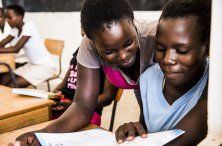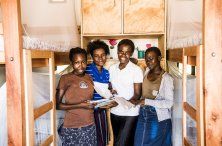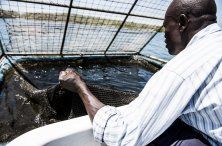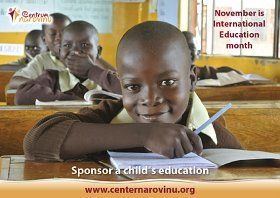SlovakAid support community center Island of Hope in the period September 2017 – September 2019
In line with the Slovak Republic Strategy for Development Cooperation with the Republic of Kenya for the period 2014-2018 and Agenda 2030, the project promotes sustainable and equitable socio-economic development for inhabitants of the isolated Rusinga Island in western Kenya in agriculture, specifically in the fishery development.
Development problem – Rusinga Island is one of the biggest islands on Lake Victoria with population about 30,000 inhabitants, of whom about half are children under 15 years. This very poor area has one of the highest mortality rates in the county, and therefore a large numbers of orphans. The island is strongly affected by the presence of malaria, HIV/AIDS, typhoid fever, TB, parasitic and other diseases. Fishing is the main economic activity in this region.
The aim of the project is to improve the quality of life of Rusinga Island inhabitants, to strengthen the economic and food security of an existing Community center by promoting economic activities in the fish farming sector. At the same time, the project focuses on the high prevalence of HIV/AIDS, Homa Bay (where the island belongs) has the highest incidence of HIV/AIDS-positive people in Kenya.
The project promotes the sustainability of an existing community center on the island, which has been gradually expanding since the year 2003. The community center has an important role on the island, providing quality education for a total of 400 children and young people, including orphans, providing health care and community awareness. It includes a kindergarten, primary school and new boarding high school, an orphanage and a 24-hour health center. In the community center, a fish farm in Lake Victoria will be established, the center is located directly on the shores of the lake, where floating cages will be housed for a total of 260,000 Tilapia fish. The production profit will financially support the operation of the community center including the clinic, part of the production will support food safety.
 County Homa Bay has the highest incidence of HIV/AIDS-positive people in Kenya (up to 26%), HIV prevalence in Kenya is stable at around 6% over the past 5 years. The main factors supporting the spread of HIV/AIDS in the area are: poverty, cultural and sexual attitude and behavior, the fishing industry networks, lifestyle related factors, health risk behavior and professional related issues. The fishing industry is associated with the phenomenon called “Jaboya”. The “Jaboya” concept entails men (fishermen or middlemen) exploiting women traders by only selling fish in exchange for sex. This concept is also used to lure young girls into sex in exchange for free fish that they can sell and get money.
County Homa Bay has the highest incidence of HIV/AIDS-positive people in Kenya (up to 26%), HIV prevalence in Kenya is stable at around 6% over the past 5 years. The main factors supporting the spread of HIV/AIDS in the area are: poverty, cultural and sexual attitude and behavior, the fishing industry networks, lifestyle related factors, health risk behavior and professional related issues. The fishing industry is associated with the phenomenon called “Jaboya”. The “Jaboya” concept entails men (fishermen or middlemen) exploiting women traders by only selling fish in exchange for sex. This concept is also used to lure young girls into sex in exchange for free fish that they can sell and get money.
There is very high prostitution in the area. Young people lack knowledge of the subject, our school has a few underage mothers. Second part of the project is the organization of a one-year seminar focusing on sex education and family planning for high school students in the community center. The seminar will raise the awareness of the most vulnerable group and the permanent introduction of sex education and parenting topics at a high school into Life Skills.
Miriam Lišková
 The project is implemented by financial means of the official development assistance of the Slovak Republic, SlovakAid.
The project is implemented by financial means of the official development assistance of the Slovak Republic, SlovakAid.



























